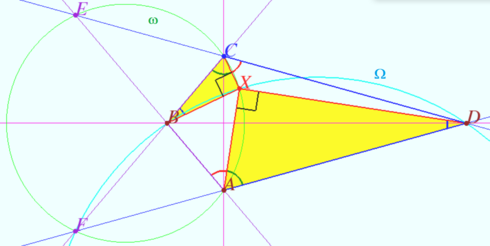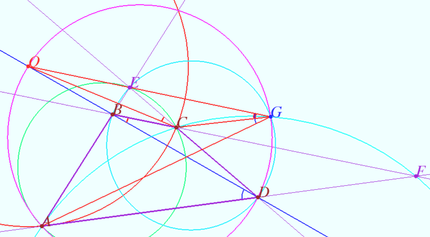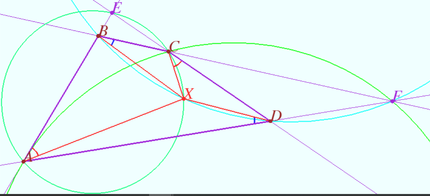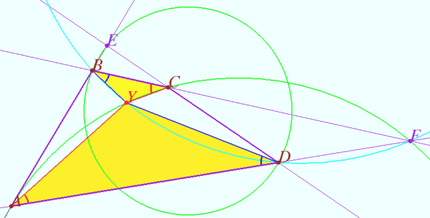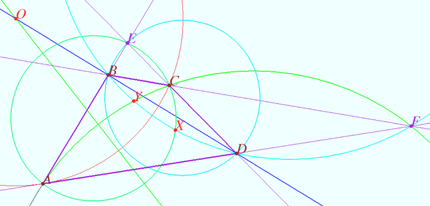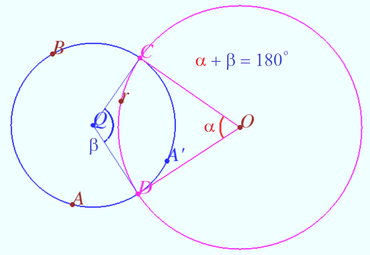Difference between revisions of "2018 IMO Problems/Problem 6"
(→Solution) |
(→Solution) |
||
| Line 61: | Line 61: | ||
Quadrangle <math>BYDF</math> is cyclic <math>\implies \angle CBY = \angle ADY.</math> | Quadrangle <math>BYDF</math> is cyclic <math>\implies \angle CBY = \angle ADY.</math> | ||
| − | Quadrangle <math> | + | Quadrangle <math>AYCF</math> is cyclic <math>\implies \angle YAD = \angle BCY.</math> |
| − | The triangles <math>\triangle YAD \sim \triangle | + | The triangles <math>\triangle YAD \sim \triangle YCB</math> by two angles, so <cmath>\frac {BC}{AD} = \frac {CY}{AY} = \frac {BY} {DY} \hspace{10mm} (1).</cmath> |
| − | The points <math>X</math> and <math>Y</math> are symmetric with respect to the circle <math>\omega</math>, since they lie on the intersection of the circles <math>ACF</math> and <math>ACE</math> symmetric with respect to <math>\omega</math> and the | + | The points <math>X</math> and <math>Y</math> are symmetric with respect to the circle <math>\omega</math>, since they lie on the intersection of the circles <math>ACF</math> and <math>ACE</math> symmetric with respect to <math>\omega</math> and the circle <math>BDF</math> orthogonal to <math>\omega.</math> |
The point <math>C</math> is symmetric to itself, the point <math>X</math> is symmetric to <math>Y</math> with respect to <math>\omega \implies \frac{CX}{CY} = \frac {R^2}{OC \cdot OY} , \frac {AX}{AY} = \frac {R^2}{OA \cdot OY}.</math> | The point <math>C</math> is symmetric to itself, the point <math>X</math> is symmetric to <math>Y</math> with respect to <math>\omega \implies \frac{CX}{CY} = \frac {R^2}{OC \cdot OY} , \frac {AX}{AY} = \frac {R^2}{OA \cdot OY}.</math> | ||
| Line 81: | Line 81: | ||
By the law of sines for <math>\triangle CDX,</math> we obtain <math>\frac {CD}{\sin \psi} = \frac {DX}{\sin \alpha}.</math> | By the law of sines for <math>\triangle CDX,</math> we obtain <math>\frac {CD}{\sin \psi} = \frac {DX}{\sin \alpha}.</math> | ||
| − | We make transformation and get <cmath>{\sin \psi} = \frac {CD}{DX} {\sin \alpha} = \frac{CD}{DX} \cdot {\frac{DX \cdot AB}{BX \cdot CD}} {\sin \alpha} = \frac {AB}{BX}\sin \alpha = \sin \psi.</ | + | We make transformation and get <cmath>{\sin \psi} = \frac {CD}{DX} {\sin \alpha} = \frac{CD}{DX} \cdot {\frac{DX \cdot AB}{BX \cdot CD}} {\sin \alpha} = \frac {AB}{BX}\sin \alpha = \sin \varphi.</cmath> |
| + | If <math>\varphi = \psi,</math> then <math>\triangle XAB \sim \triangle XCD \implies \frac {CD}{AB} = \frac {BX}{DX} = \frac{AX}{CX} = \frac {AD}{BC}.</math> | ||
| + | <math>CD \cdot BC = AB \cdot AD.</math> Given that <math>AB \cdot CD = BC \cdot DA \implies BC \cdot (CD – AD) = AB \cdot (AD – CD)\implies AD = CD, AB = BC.</math> This is a special case. | ||
| + | In all other cases, the equality of the sines follows <math>\psi = 180° – \varphi \implies \varphi + \psi = 180°.</math> | ||
<i><b>Claim 1</b></i> Let <math>A, C,</math> and <math>E</math> be arbitrary points on a circle <math>\omega, l</math> be the perpendicular bisector to the segment <math>AC.</math> Then the straight lines <math>AE</math> and <math>CE</math> intersect <math>l</math> at the points <math>B</math> and <math>D,</math> symmetric with respect to <math>\omega.</math> | <i><b>Claim 1</b></i> Let <math>A, C,</math> and <math>E</math> be arbitrary points on a circle <math>\omega, l</math> be the perpendicular bisector to the segment <math>AC.</math> Then the straight lines <math>AE</math> and <math>CE</math> intersect <math>l</math> at the points <math>B</math> and <math>D,</math> symmetric with respect to <math>\omega.</math> | ||
Revision as of 11:24, 19 August 2022
A convex quadrilateral ![]() satisfies
satisfies ![]() Point
Point ![]() lies inside
lies inside
![]() so that
so that
![]() and
and ![]() Prove that
Prove that ![]()
Solution
Special case
We construct point ![]() and prove that
and prove that ![]() coincides with the point
coincides with the point ![]()
Let ![]() and
and ![]()
Let ![]() and
and ![]() be the intersection points of
be the intersection points of ![]() and
and ![]() and
and ![]() and
and ![]() respectively.
respectively.
The points ![]() and
and ![]() are symmetric with respect to the circle
are symmetric with respect to the circle ![]() (Claim 1).
(Claim 1).
The circle ![]() is orthogonal to the circle
is orthogonal to the circle ![]() (Claim 2).
(Claim 2).
Let ![]() be the point of intersection of the circles
be the point of intersection of the circles ![]() and
and ![]() Quadrilateral
Quadrilateral ![]() is cyclic
is cyclic ![]()
![]()
Similarly, quadrangle ![]() is cyclic
is cyclic ![]() .
.
This means that point ![]() coincides with the point
coincides with the point ![]() .
.
![]() of
of ![]()
![]() of
of ![]()
The sum ![]() (Claim 3)
(Claim 3) ![]()
![]()
Similarly, ![]()
Common case
Denote by ![]() the intersection point of the perpendicular bisector of
the intersection point of the perpendicular bisector of ![]() and
and ![]() Let
Let ![]() be a circle (red) with center
be a circle (red) with center ![]() and radius
and radius ![]()
The points ![]() and
and ![]() are symmetric with respect to the circle
are symmetric with respect to the circle ![]() (Claim 1).
(Claim 1).
The circles ![]() and
and ![]() are orthogonal to the circle
are orthogonal to the circle ![]() (Claim 2).
(Claim 2).
Circles ![]() and
and ![]() are symmetric with respect to the circle
are symmetric with respect to the circle ![]() (Lemma).
(Lemma).
Denote by ![]() the point of intersection of the circles
the point of intersection of the circles ![]() and
and ![]() Quadrangle
Quadrangle ![]() is cyclic
is cyclic ![]() (see Special case).
Similarly, quadrangle
(see Special case).
Similarly, quadrangle ![]() is cyclic
is cyclic ![]()
The required point ![]() is constructed.
is constructed.
Denote by ![]() the point of intersection of circles
the point of intersection of circles ![]() and
and ![]()
Quadrangle ![]() is cyclic
is cyclic ![]()
Quadrangle ![]() is cyclic
is cyclic ![]()
The triangles ![]() by two angles, so
by two angles, so ![]()
The points ![]() and
and ![]() are symmetric with respect to the circle
are symmetric with respect to the circle ![]() , since they lie on the intersection of the circles
, since they lie on the intersection of the circles ![]() and
and ![]() symmetric with respect to
symmetric with respect to ![]() and the circle
and the circle ![]() orthogonal to
orthogonal to ![]()
The point ![]() is symmetric to itself, the point
is symmetric to itself, the point ![]() is symmetric to
is symmetric to ![]() with respect to
with respect to ![]() Usung
Usung ![]() and the equality
and the equality ![]() we get
we get ![]() The point
The point ![]() is symmetric to itself, the point
is symmetric to itself, the point ![]() is symmetric to
is symmetric to ![]() with respect to
with respect to ![]()
![]()
![]() The point
The point ![]() is symmetric to
is symmetric to ![]() and the point
and the point ![]() is symmetric to
is symmetric to ![]() with respect to
with respect to ![]() hence
hence
![]()
![]() Denote
Denote ![]()
By the law of sines for ![]() we obtain
we obtain ![]()
By the law of sines for ![]() we obtain
we obtain ![]()
We make transformation and get ![]() If
If ![]() then
then ![]()
![]() Given that
Given that ![]() This is a special case.
This is a special case.
In all other cases, the equality of the sines follows ![]()
Claim 1 Let ![]() and
and ![]() be arbitrary points on a circle
be arbitrary points on a circle ![]() be the perpendicular bisector to the segment
be the perpendicular bisector to the segment ![]() Then the straight lines
Then the straight lines ![]() and
and ![]() intersect
intersect ![]() at the points
at the points ![]() and
and ![]() symmetric with respect to
symmetric with respect to ![]()
Claim 2 Let points ![]() and
and ![]() be symmetric with respect to the circle
be symmetric with respect to the circle ![]() Then any circle
Then any circle ![]() passing through these points is orthogonal to
passing through these points is orthogonal to ![]()
Claim 3 The sum of the arcs between the points of intersection of two perpendicular circles is ![]() In the figure they are a blue and red arcs
In the figure they are a blue and red arcs ![]()





